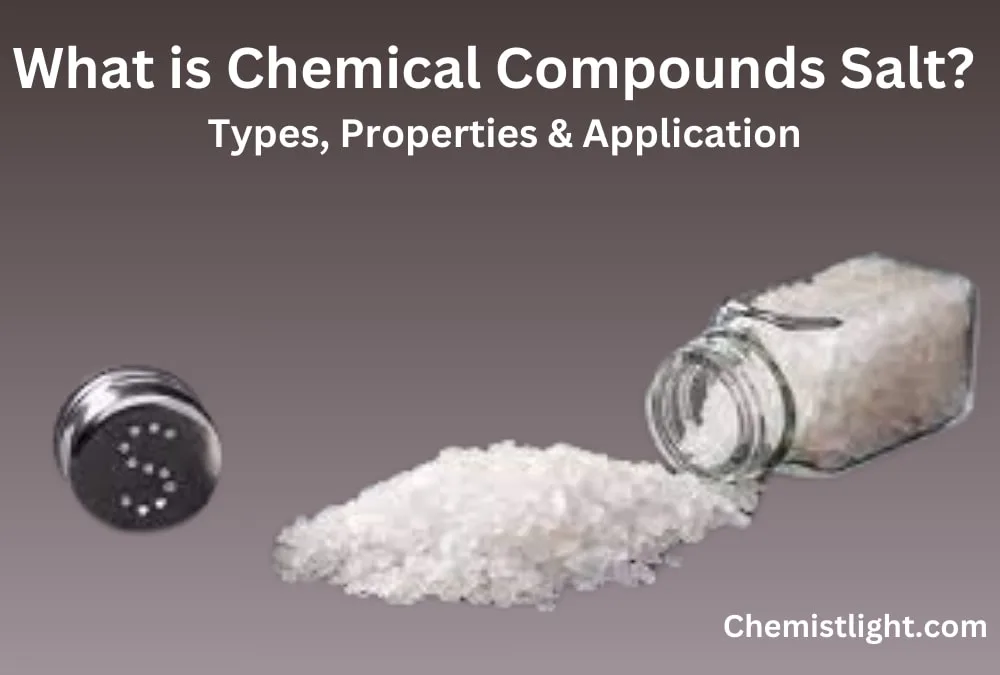What is Chemical Compounds Salt? | Types & Properties

Chemical salts, including millions of different types, are used extensively across various scientific, industrial, and domestic applications. This is partly due to the fact that they are included in numerous products. The presumably most people do not have a comprehensive understanding of chemical salts and their properties. The ‘ Chemical Compounds Salt’, in more detail about their definition, formation, and uses given here.
What is Chemical Compounds Salt?
In chemistry, it is common to use the term salt contained one or more cations bound to one or more anions. Table salt is one which is most familiar, chemical formula of which is NaCl. It has positively charged sodium ions in it as well as negatively charged chloride ions). Some chemicals compounds salt with its chemical formula are in a tabular form as provided below.
| Chemical Salt | Formula |
| Sodium chloride (Table salt) | NaCl |
| Magnesium sulfate (Epsom salt) | MgSO₄ |
| Calcium carbonate (Limestone) | CaCO₃ |
| Potassium nitrate (Saltpeter) | KNO₃ |
| Sodium bicarbonate (Baking soda) | NaHCO₃ |
| Sodium acetate (Baking powder) | NaC₂H₃O₂ |
| Ammonium chloride | NH₄Cl |
| Copper sulfate | CuSO₄ |
| Iron(III) chloride | FeCl₃ |
| Potassium bromide | KBr |
Formation of Chemical Salts
Ionic bonding, which involves the formation of compounds through the interaction of ions, is the process by which most salts are formed. This takes place at a time when atoms share their electrons, attaining a state where they hold both positive and negative charges. The attractive force of opposing charges holds the ions together to form a chemical compound. Furthermore, different types of salt exist in chemistry, which necessitates a unique approach to separate ions through the process of ion exchange.
Types of Salt in Chemistry
Chemical salts are numerous and could differ in characteristics and usage in an endeavor. Some common types include:
1. Metal Salts: It is a combination of a metal cation and a non-metal anion. It includes Sodium chloride NaCl, Potassium nitrate KNO3 and Calcium carbonate CaCO3.
2. Non-metal Salts: The Inorganic salts are formed with non-metal Cations and anions. The some examples are; Ammonium sulphate – [(NH4)2SO4] and Hydrogen fluoride (HF).
3. Double Salts: With more than one cation or anion involved. The one example is compound such as alum which is a double salt of potassium sulfate and aluminum sulfate.
4. Complex Salts: These salts possess large ions such as the ferricyanide [Fe(CN)6]3- and chromate.
5. Acid Salts: Some examples of soluble salts include sodium dihydrogen phosphate or Sodium Bicarbonate and calcium hydrogen carbonate respectively.
6. Basic Salts: Others include, aluminum hydroxide, Al(OH)3, and bismuth subcarbonate, Bi(OH)CO3.
Chemical Properties of Salt
It’s elementary composition and a variety of uses in chemistry serve numerous industries and are present in daily lives. The chemical formula and properties of salt refer to sodium chloride (NaCl). Here are the key chemical properties of salt:
1. Ionic Bonding
The more usual salt has an empirical formula of NaCl. Sodium ions (Na+) form ionic bonds with chloride ions (Cl-) through the attraction of opposite charges. This type of bonding occurs when ions with opposite charges are attracted to each other. So, they produce a stable compound.
2. Solubility
The phenomenon of solubility shows that salt dissolves easily in this polar solvent. Sodium and chloride ions are dissolved in an aqueous medium by breaking the ionic bonds between them. They are evenly distributed in water and remain invisibly dissolved, forming a clear solution.
3. Ionization
In water solution, salt dissolves and dissociates into sodium and ions chloride ions, Na & Cl respectively. This process is known to be reversible and hence when the water evaporates one can note that the ions are capable of coming together to form salt in a solid state.
4. Electrolyte Properties
This is because on dissolving in water the salt forms ions which allow the electricity to flow through the aqueous solution. Through the dissolving process, the commixed water molecules yield Na+ and Cl- ions which enable electric current flow hence making saltwater an electrolyte.
5. Reaction with Acids and Bases
It is the transfer of H+ ions in acids with OH- ions with subsequent formation of new salts and water during neutralisation reactions. For instance you will be able to find out the reaction of a gas like hydrochloric acid (HCl) with a metal or sodium hydroxide (NaOH) which results in the formation of a salt like NaCl and water.
HCl + NaOH → NaCl + H2O
6. Hygroscopic Nature
The nature of salt is that it is hygroscopic in character, this is always in the capacity of nature to absorb moisture present in the air. It is effective in use since it is good for the removal of moisture which makes it a good absorbent; the property makes it useful in several applications where humidity is a concern.
7. Melting and Boiling Points
Salt is a material that has quite a high melting point 801°C as well as a relatively high boiling point 1413°C. This stability at high temperatures makes it a useful component in several industries.
8. Chemical Stability
The results also showed that sodium chloride has low chemical reactivity under normal facility conditions as it could not easily react with the majority of substances. This stability makes it long lasting and useful It is for this reasons that it is very common to find it being used in various industries.
Applications of Chemical Compounds Salt
Chemical Compounds salt are versatile and are used commonly by different industries and in different settings since they have different qualities. Here are some key applications of chemical salts:
1. Food Industry
Seasoning: One of the most familiar seasoning, greatly used across the world is common table salt which goes by the name sodium chloride.
Preservation: Salting is used as a method of preservation as in pickling and curing it helps in Check on the activities of microorganisms and hence increase the shelf life of a food product.
2. Water Treatment
Water softeners containing sodium chloride and potassium chloride help eliminate calcium and magnesium ions to hinder the development of a thicker layer of scale in pipes and equipment.
3. Chemical Manufacturing
Mainly, chemical salts are used in the production of chemicals and pharmaceuticals as important precursors. They can serve as a combination of an agent, another substance to which a reaction occurs, or a component of a reaction.
4. Agriculture
Ammonium nitrate and potassium chloride are some common salts used in the synthesis of fertilizers to supply the necessary nutrients in the form of nitrogen and potassium to support the plant growth and raise the crop yield.
5. Medicine and Pharmaceuticals
Buffering Agents: Chemical salts of buffers are employed by the pharmaceutical industry in formulations to set their pH in order to maintain the stability and efficiency of products.
Intravenous Solutions: Most often, healthcare providers prescribe saline solution, which consists of sodium chloride dissolved in water, for hydration or administration of specific drugs.
6. Metallurgy
Leaching and electrolysis of ores, involve use of salts to get metals from them since metals have a tendency of bonding with salts.
7. Textile Industry
Some are employed as mordant which help in fixing of dyes and other material applied on the fabrics during the dyeing and printing processes of the textile industry.
8. Deicing and Antifreeze
Winter Road Maintenance: Sodium chloride or salt is used to prevent the formation of ice often during winter on roads and paths by spreading it on these areas.
Antifreeze: Calcium chloride and other salts are added to anti-freeze to reduce the freezing point of liquids. It may be incorporated in automobile engines.
9. Cleaning and Hygiene
Ions, such as silver or iodine, are used for bacteriostatic/cidal properties in disinfecting agents and cleaning compounds.
Toothpaste: Silica is one of the abrasive substances that are added in the formulation of toothpaste products.
10. Photography
Solutions used in the process of developing photographs involve the use of chemical salts to amplify and stabilize images on photographic film or paper.
Conclusion
Chemical compound salts are the most basic forms of compounds that have so much utility in many industrial fields. They play such valuable roles in our day to day livelihood . They are capable of forming stable structures following the arrangements of ions through ionic bond; from seasoning our foods to controlling the directions of crop growth and production of most important chemicals. Knowledge of chemical salts which forms the formation of essentials improves help in our appreciation
What is the Chemical Formula for Epsom Salt?
The formal chemical writing for Epsom Salt is MgSO4•7H2O meaning that its full name is magnesium sulfate heptahydrate. Among the compounds included in Epsom salt, are magnesium ions (Mg2+), sulfate ions (SO42-), and water molecules (H2O).
What Chemical is Bath Salts?
The drug called “bath salts” are most often synthetic cathinones – new generation stimulants that have gained popularity in Russia in recent years. These chemicals act in a way that stimulates neurons like amphetamines and might cause addiction. However, there is a type of substance sold in commercial markets referred to as “bath salts”. But it is vital to understand that these products can contain many different substances including some that are dangerous.
What is Salt Water Chemical Formula?
The formula to identify saltwater, also referred to as sea water, is H2O (water) with salts dissolved in it. Sodium chloride (NaCl) is the most typical example of a salt. The above-mentioned compound consists of sodium and chloride ions and offers a saline solution. Which is similar to seawater.
What is the Chemical Composition Rock Salt?
The evaporation of ancient saltwater primarily composes rock salt, which is a crystalline mineral formed from sodium chloride (NaCl). Its chemical composition consists predominantly of sodium ions and chloride ions, making it a common and essential mineral in various industries.
What is the Chemical Composition of Sea Salt?
Chemical composition of sea salt is as follows: Moisture, magnesium chloride, calcium chloride, potassium chloride, sodium chloride, sulfate, bicarbonate, and trace amounts of other elements such as iron, manganese, and copper.


